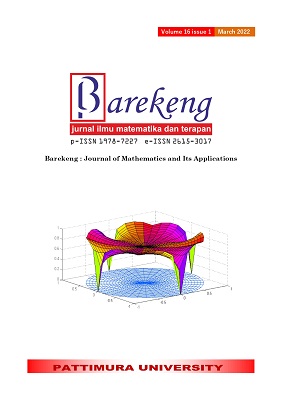COMPARISON OF SARIMA, SVR, AND GA-SVR METHODS FOR FORECASTING THE NUMBER OF RAINY DAYS IN BENGKULU CITY
Abstract
The number of rainy days is a calculation of the rainy days that occur in one month. In recent years, there has been a decrease in rainy days in some parts of Indonesia. One of the areas at risk of quite a high decreasing number of rainy days is the Bengkulu City area. The decrease in the number of rainy days is one of the impacts caused by climate change. The community will feel the impact of climate change-related to the season, especially those working in the agricultural sector. In compiling the planting calendar, it is necessary to consider the seasons to estimate water availability. This study aimed to forecast the data on the number of rainy days in Bengkulu City in the period January 2000 to December 2020 using the Seasonal Autoregressive Integrated Moving Average (SARIMA), Support Vector Regression (SVR), and Genetic Algorithm Support Vector Regression (GA-SVR) methods. The criteria for selecting the best model used was Mean Absolute Deviation (MAD). The MAD value in the SARIMA method was 4,16, 5,07 in the SVR model, and 3,67 in the GA-SVR model. Based on these results, it can be concluded that the GA-SVR model is the best model for forecasting the number of rainy days in Bengkulu City.
Downloads
References
N. Binternagel, “Adaptasi dan Mitigasi Perubahan Iklim Global,” ["Adaptation and Mitigation of Global Climate Change,"] no. October, 2009.
TK Manik, B. Rosadi, and E. Nurhayati, “Mengkaji dampak perubahan iklim terhadap distribusi curah hujan lokal di propinsi lampung.” [“Examining the impact of climate change on local rainfall distribution in Lampung province.”]
Central Bureau of Statistics, “Statistik Lingkungan Hidup Indonesia Enviroment Statistic of Indonesia 2017,” [“Environmental Statistics of Indonesia Environmental Statistics of Indonesia 2017,”] Badan Pus. stats., vol. 91, no. 1, pp. 186–189, 2017, [Online]. Available: http://www.un-ilibrary.org/economic-and-social-development/the-sustainable-development-goals-report-2017_4d038e1e-en.
Central Bureau of Statistics, “Statistik Lingkungan Hidup Indonesia (SLHI) 2018,” [“Indonesian Environmental Statistics (SLHI) 2018,”] Badan Pus. stats. Indonesia., pp. 1–43, 2018, doi: 3305001.
[BPS] Central Bureau of Statistics, “Statistik Lingkungan Indonesia 2019,” [“Indonesian Environmental Statistics 2019,”] Badan Pus. stats., pp. 1-224, 2019,
[Online]. Available: https://www.bps.go.id/publication/2018/12/07/d8cbb5465bd1d3138c21fc80/statistik-lingungan-live-indonesia 2018.html.
S. Wei and CP Soon, “Genetic algorithm-based text clustering technique,” Lect. Notes Comput. science. (including Subser. Lect. Notes Artif. Intell. Lect. Notes Bioinformatics), vol. 4221 LNCS, pp. 779–782, 2006, doi:10.1007/11881070_103.
HR Makridakis S, Wheelwright SC, “1 / the Forecasting Perspective,” Forecast. methods app., pp. 1–632, 1997.
Rob J Hyndman and A. George, “Forecasting: Principles and Practice,” Princ. Optimistic. Dec., no. September, pp. 421–455, 2018, [Online]. Available: https://otexts.com/fpp2/index.html.
P. Meesad and RI Rasel, “Predicting stock market price using support vector regression,” 2013 Int. conf. Informatics, Electron. Vision, ICIEV 2013, no. May, 2013, doi:10.1109/ICIEV.2013.6572570.
NPN Hendayanti and M. Nurhidayati, “Perbandingan Metode Seasonal Autoregressive Integrated Moving Average (SARIMA) dengan Support Vector Regression (SVR) dalam Memprediksi Jumlah Kunjungan Wisatawan Mancanegara ke Bali,” ["Comparison of the Seasonal Autoregressive Integrated Moving Average (SARIMA) Method with Support Vector Regression (SVR) in Predicting the Number of International Tourist Visits to Bali,"] J. Varian, vol. 3, no. 2, pp. 149–162, 2020, doi:10.30812/varian.v3i2.668.
Q. Lou, Q. Lyu, Z. Na, D. Ma, and X. Ma, “Short-term electric power demand forecasting using a hybrid model of SARIMA and SVR,” IOP Conf. Ser. Earth Environment. science., vol. 619, no. 1, 2020, doi:10.1088/1755-1315/619/1/012035.
M. Shehab, H. Alshawabkah, L. Abualigah, and N. AL-Madi, “Enhanced a hybrid moth-flame optimization algorithm using new selection schemes,” Eng. Comput., vol. 37, no. 4, pp. 2931–2956, 2021, doi: 10.1007/s00366-020-00971-7.
EL Amalia, DW Wibowo, HS Pakpahan, and O. Anandiya, “Forecasting Error Calculation with Mean Absolute Deviation and Mean Absolute Percentage Error Forecasting Error Calculation with Mean Absolute Deviation and Mean Absolute Percentage Error.”
S. Sande and ML Privalsky, “Identification of TRACs (T3 receptor-associating cofactors), a family of cofactors that associate with, and modulate the activity of, nuclear hormone receptors,” Mol. Endocrinol., vol. 10, no. 7, pp. 813–825, 1996, doi:10.1210/me.10.7.813.
X. Tang, L. Wang, J. Cheng, J. Chen, and VS Sheng, “Forecasting model based on information-granulated GA-SVR and ARIMA for producer price index,” Comput. mater. Contin., vol. 58, no. 2, pp. 463–491, 2019, doi:10.32604/cmc.2019.03816.
Authors who publish with this Journal agree to the following terms:
- Author retain copyright and grant the journal right of first publication with the work simultaneously licensed under a creative commons attribution license that allow others to share the work within an acknowledgement of the work’s authorship and initial publication of this journal.
- Authors are able to enter into separate, additional contractual arrangement for the non-exclusive distribution of the journal’s published version of the work (e.g. acknowledgement of its initial publication in this journal).
- Authors are permitted and encouraged to post their work online (e.g. in institutional repositories or on their websites) prior to and during the submission process, as it can lead to productive exchanges, as well as earlier and greater citation of published works.






1.gif)



